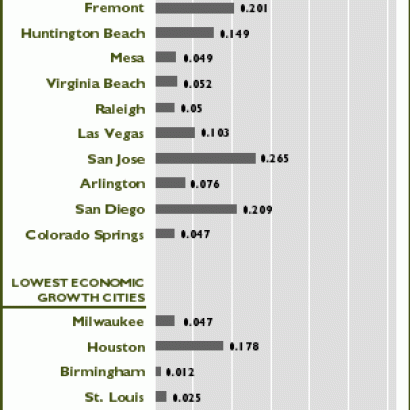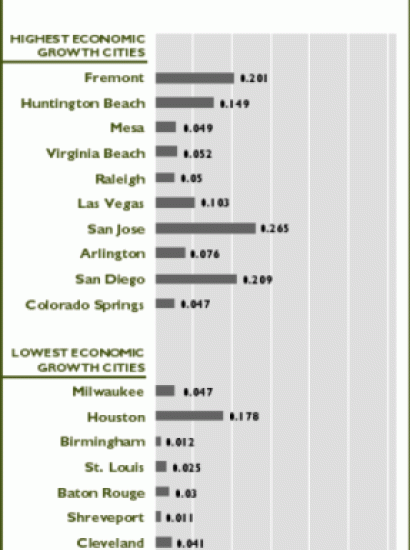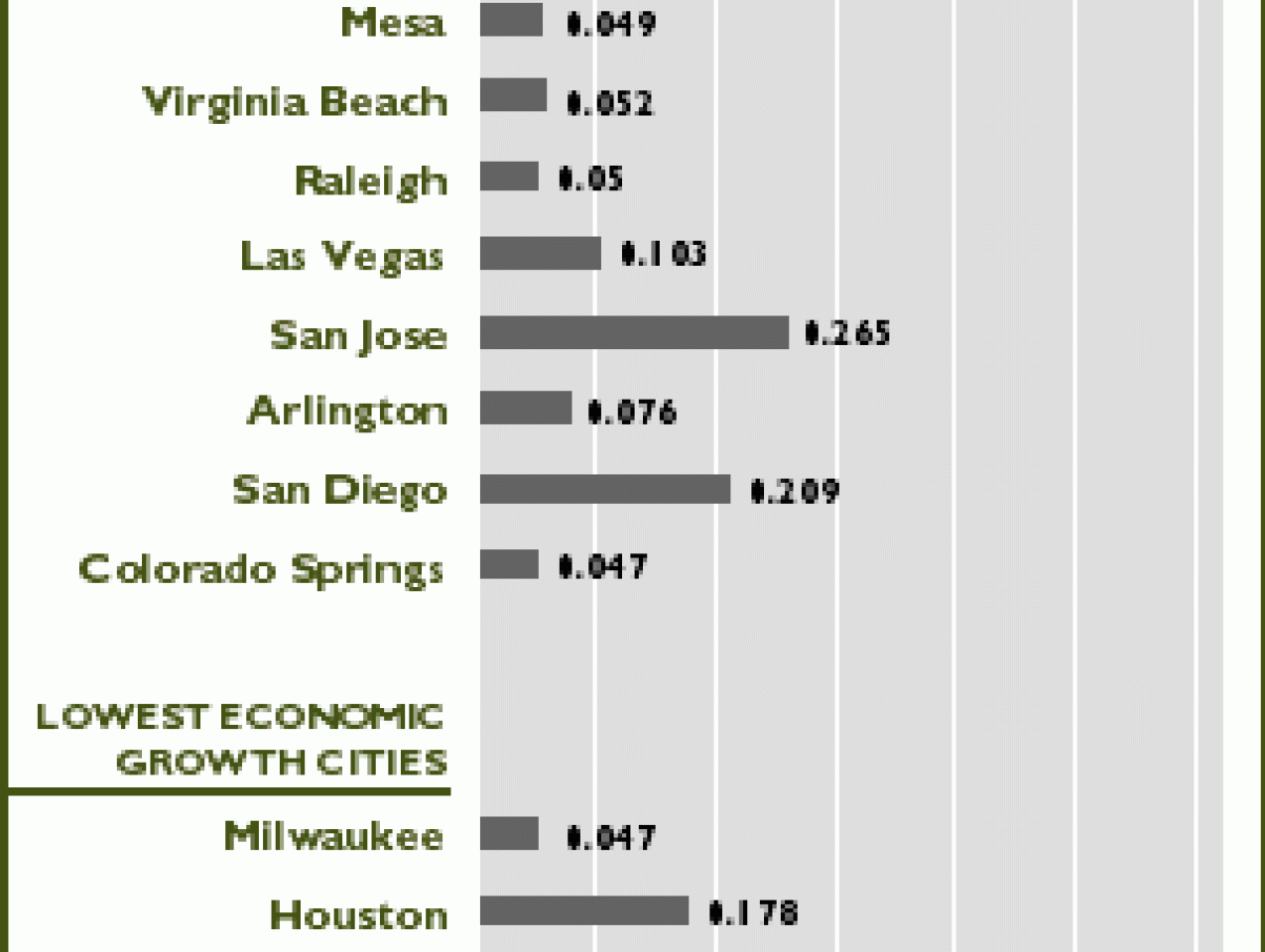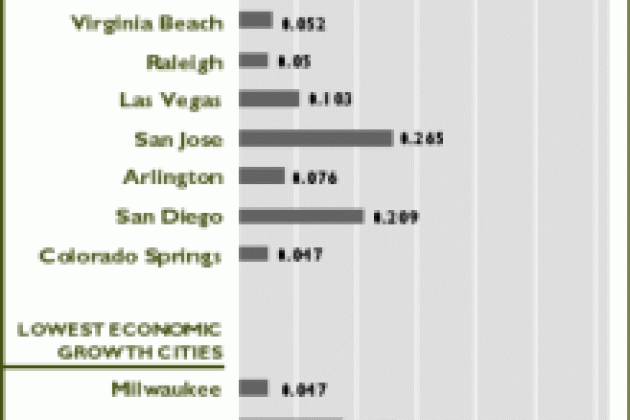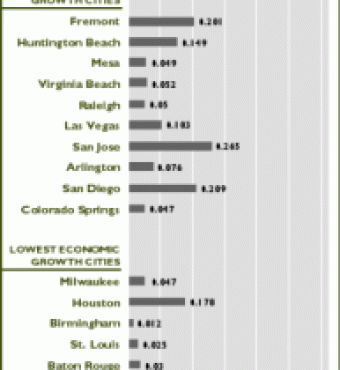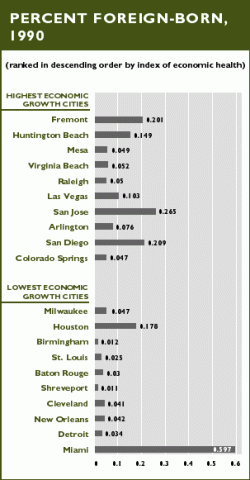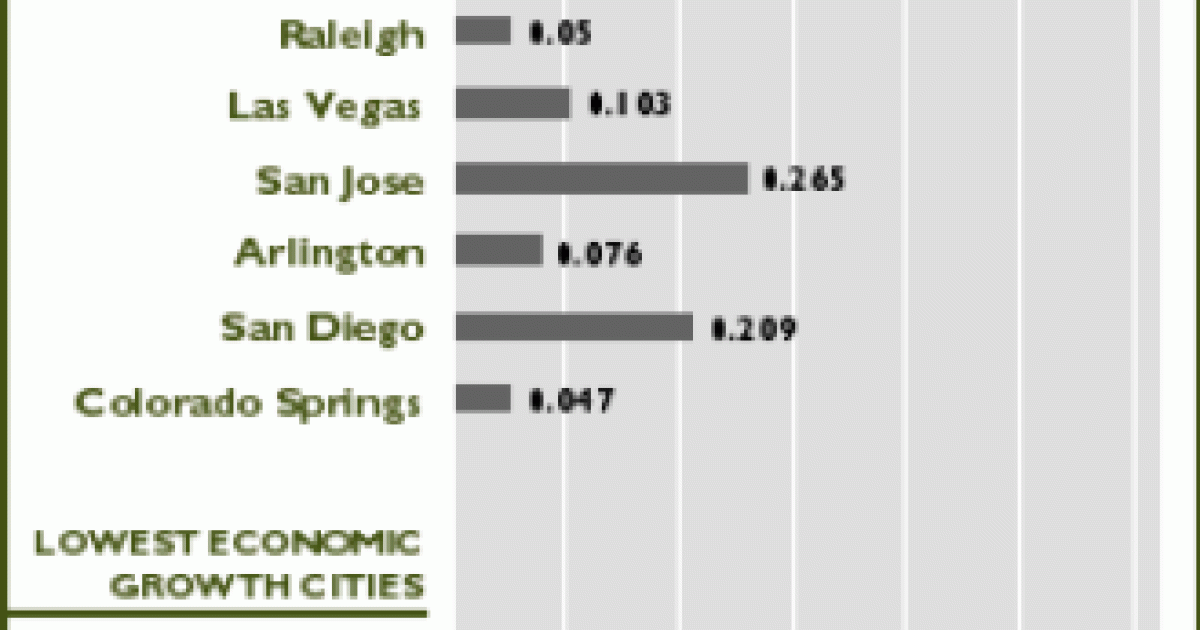- Immigration
- State & Local
- California
- Law & Policy
More than half of all immigrants in the United States reside in just seven cities: Los Angeles, New York, Chicago, Miami, San Diego, Houston, and San Francisco. A controversial issue is whether immigrants are a benefit or a burden to these areas. A 1997 National Academy of Sciences study reports that "immigrants add as much as $10 billion to the national economy each year," but "in areas with high concentrations of low-skilled, low-paid immigrants," they impose net costs on U.S.-born workers. Furthermore, a 1997 Rand study suggests that immigrants are now becoming an economic burden on the cities of California. This article questions those findings.
Examining a range of economic variables for the eighty-five largest U.S. cities over the period 1980–1994, my research indicates that those cities with heavy concentrations of immigrants outperformed cities with few immigrants. Compared with low-immigrant cities, high-immigrant cities had double the job creation rate, higher per capita incomes, lower poverty rates, and 20 percent less crime. Unemployment rates, however, were unusually large in high-immigrant cities. These findings do not answer the critical questions of whether the immigrants cause the better urban conditions or whether benign urban conditions attract the immigrants. But they do refute the assertion that the economic decline of central cities is caused by immigration. That assertion cannot be true because, with few exceptions, the U.S. cities in greatest despair today--Detroit, Saint Louis, Buffalo, Rochester, Gary--have virtually no immigrants.
What is the fiscal and economic impact of immigrants on the cities where they live? This question goes to the heart of the controversy over America's ability to assimilate immigrants into our economy and social infrastructure without imposing an undue burden on U.S. citizens. It is also a critical policy issue in the current debate over what is the "right number" of immigrants to admit to the United States each year.
The presumption among policymakers is that immigrants impose heavy fiscal and economic burdens. For example, Governor Lawton Chiles of Florida has complained that "federal immigration policy has created a nightmare for state and local governments."
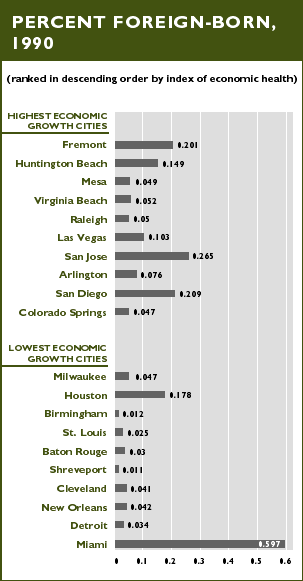
The nightmare is said to take many forms. One is an undesirable cultural transformation. Newsweek recently raised the alarm for Californians with the headline "Los Angeles 2010: A Latino Subcontinent." Within a generation, predicts the article, "California will be demographically, culturally, and economically distinct from the rest of America." Gordon J. McDonald, former chief of the U.S. Border Patrol, is even more blunt in his assessment of the urban impact of immigrants: "Major cities have already been turned into extensions of foreign countries," he warns. "Aliens threaten to seize political power within a few short years."
Another problem allegedly created by large concentrations of immigrants in cities is unemployment. Brown immigrants are said to be pushing black Americans out of the job market. Still another impact of competition from immigrants in inner cities is white flight. "In the last half of the 1980s, for every ten immigrants who arrived [in New York, Chicago, Los Angeles, and Houston], nine residents left for elsewhere," claims a story in the New York Times Magazine. Immigration may be leading to the balkanization of America's once-mighty industrial cities.
What is beyond debate is that immigrants have a profound demographic, economic, and fiscal impact on America's largest central cities. The majority of all immigrants reside in just seven cities. Most of the rest of the nation is negligibly affected by immigration.
There is also little question that many of America's largest cities--Detroit, Saint Louis, Buffalo, Newark, New York, Philadelphia, for example--have been suffering from a severe economic erosion during the past quarter century. The signs of urban sclerosis are evident in statistics on rising crime rates, increasing poverty levels, and losses of jobs, businesses, and the white middle class (though in the current economic recovery, the lot of central cities has improved). Yet not all America's central cities are deteriorating. In fact, many, such as Charlotte, Las Vegas, San Jose, San Diego, Austin, and Seattle, for example, are booming. Other cities, such as Dallas and Pittsburgh, are enjoying an economic renaissance that seemed improbable ten or fifteen years ago.
The critical policy issue is whether immigrants contribute to economic decline in central cities. Recently I conducted a systematic assessment of the impact of immigration on cities. I contrasted the economic condition of high-immigration cities with that of low-immigration cities over the period 1980–1990 (or 1980–1994, when those data are available). I examined all eighty-five of the most populous (200,000 or more) U.S. cities.
| On eight of the nine variables I examined, high-immigration cities perform better, not worse, than low-immigration cities. |
On eight of the nine fiscal and economic variables I examined, high-immigration cities perform better, not worse, than low-immigration cities. The higher a city's percentage of foreign-born population, the higher its subsequent population growth, the higher its subsequent growth in employment, the higher its per capita income, the faster its increase in per capita income, the lower its poverty rate, the lower its subsequent increase in poverty, the lower its crime rate, and the lower its tax burden. The only economic variable on which high-immigration cities fared worse than low-immigration cities was the unemployment rate, which was higher in high-immigration cities than in low-immigration cities. The evidence suggests that there is some native worker dislocation in cities with high concentrations of immigrants.
The median foreign-born population of the ten most prosperous cities in the 1980s was 9.0 percent (see the accompanying chart). Yet in the ten fastest-declining cities, the median foreign-born population in 1990 was just 3.8 percent. In fact, of the twelve fastest-declining large cities in the United States in the 1980s, only two, Miami and Houston, had higher-than-average immigration. And Houston's decline was clearly a result of the oil bust, not high immigration.
These findings do not prove that immigrants cause prosperity in states and cities. But they challenge the opposite charge--that immigrants cause economic decline.
Nearly two hundred years ago James Madison observed: "That part of America that has encouraged [foreigners] has advanced most rapidly in population, agriculture, and in the arts." This appears to have been precisely the case in the 1980s.








